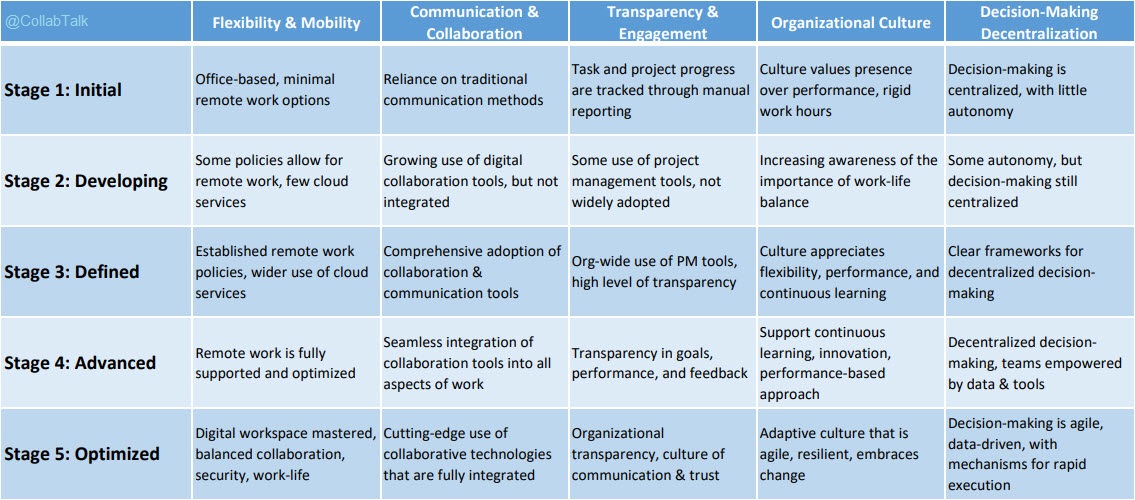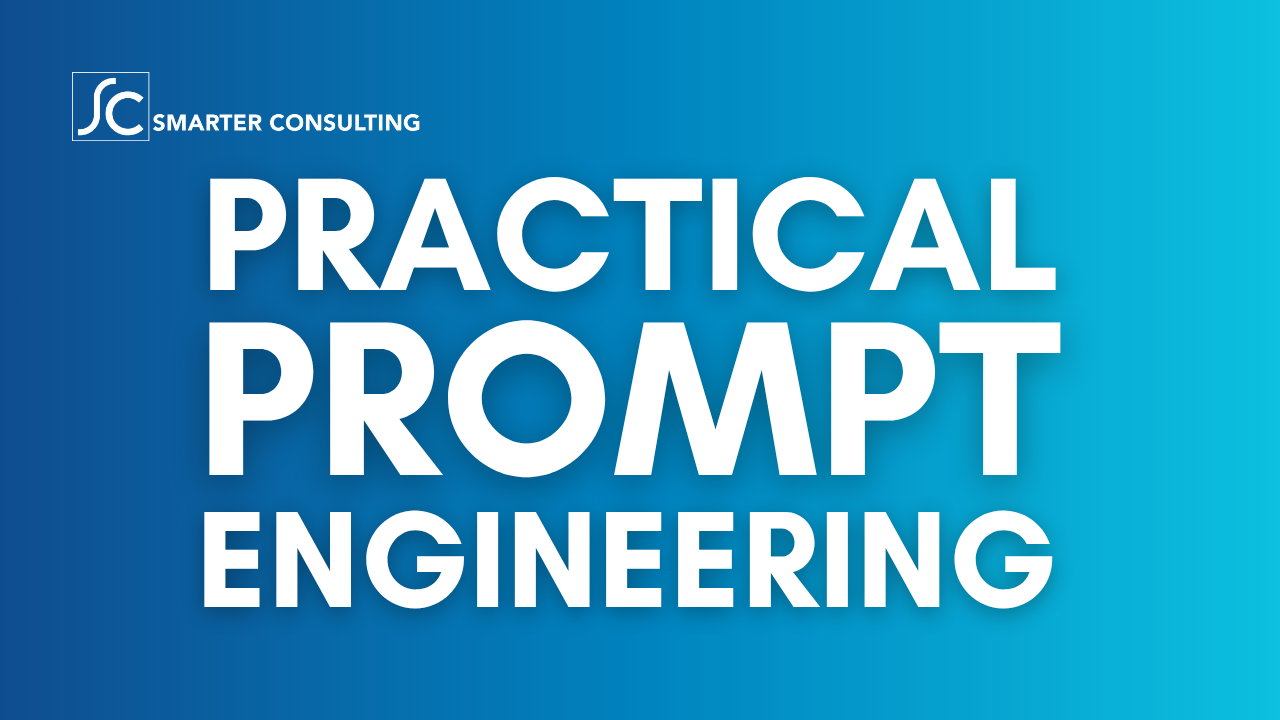Five-Stage Maturity Model for Digital Collaboration
In our second article (2/3) of the Future of Work series, we delve into a strategic 5-stage Maturity Model designed to navigate the complexities of digital transformation in the workplace. This model provides a framework to evaluate and enhance key areas such as flexibility, collaboration, transparency, culture, and decentralized decision-making, all within the rapidly evolving realms of cloud computing, collaboration technology, and social tech. I’ve created this model to complement, not replace the Microsoft 365 Maturity Model for those familiar with that effort, providing a broader view of collaboration and communication change within the modern workplace, regardless of your chosen technology.
Through this lens, organizations can assess their current digital maturity and identify clear, actionable steps to cultivate a more innovative and efficient work environment. This streamlined approach to transformation empowers businesses to not just respond to technological advancements but to proactively lead in defining the future of work. Join us as we chart a path from initial adoption to optimized digital integration.
Stage 1: Initial
Organizations at this stage are starting their digital transformation journey. They have traditional office-based work environments and may utilize basic cloud services sporadically. The focus here is to introduce foundational tools for remote work and to begin the cultural shift towards valuing flexibility and performance over presence.
Flexibility and Mobility
-
- Definition: Work is primarily office-based, with minimal remote work options. Use of cloud services is sporadic and not fully integrated into daily operations.
- Improvement Path: Begin by adopting basic cloud services for file sharing and communication to introduce the concept of remote work.
Communication and Collaboration
-
- Definition: Reliance on traditional communication methods (email, phone calls). Limited use of instant messaging platforms or collaborative tools.
- Improvement Path: Introduce team collaboration platforms (e.g., Slack, Microsoft Teams) for real-time communication and collaboration on projects.
Transparency and Engagement
-
- Definition: Task and project progress are tracked through manual reporting or not at all. Employee engagement initiatives are minimal.
- Improvement Path: Implement basic project management tools (e.g., Trello, Asana) to start tracking projects and tasks more transparently.
Organizational Culture
-
- Definition: A culture that values presence over performance, with rigid work hours and minimal trust in remote work.
- Improvement Path: Begin cultural shift by promoting flexibility in work hours and recognizing output over hours logged.
Decision-Making Decentralization
-
- Definition: Decision-making is centralized, with little autonomy given to individual teams or employees.
- Improvement Path: Start small by empowering teams with decision-making on minor projects or tasks.
Stage 2: Developing
 At this level, organizations are developing their digital capabilities. Some remote work policies are in place, and digital tools are used for communication and collaboration, but not yet fully integrated. The goal is to standardize digital processes and foster a culture that begins to embrace the benefits of flexible and remote work.
At this level, organizations are developing their digital capabilities. Some remote work policies are in place, and digital tools are used for communication and collaboration, but not yet fully integrated. The goal is to standardize digital processes and foster a culture that begins to embrace the benefits of flexible and remote work.
Flexibility and Mobility
-
- Definition: Some policies allow for remote work, with increasing adoption of cloud services for operational needs.
- Improvement Path: Expand remote work policies and increase reliance on cloud platforms for a wider range of business functions.
Communication and Collaboration
-
- Definition: Growing use of digital collaboration tools, but not fully integrated into daily work practices.
- Improvement Path: Encourage the use of collaborative tools for all projects and integrate these tools into standard operating procedures.
Transparency and Engagement
-
- Definition: Use of project management tools is becoming more common, but not universally adopted across the organization.
- Improvement Path: Standardize the use of project management tools and introduce internal social platforms to enhance engagement.
Organizational Culture
-
- Definition: Increasing awareness of the importance of work-life balance and performance-based evaluation, but inconsistently applied.
- Improvement Path: Develop policies that consistently support work-life balance and formalize performance-based evaluations.
Decision-Making Decentralization
-
- Definition: Some teams are given more autonomy, but widespread decentralization of decision-making has not been achieved.
- Improvement Path: Expand autonomy to more teams and provide training on decision-making processes and accountability.
Stage 3: Defined
Organizations in the Defined stage have established comprehensive remote work policies and use cloud computing extensively. There is a significant focus on transparency and employee engagement, with a cultural shift towards continuous learning. Teams are given more decision-making autonomy, with a growing focus on outcomes.
Flexibility and Mobility
-
- Definition: Established remote work policies and comprehensive use of cloud computing across the organization.
- Improvement Path: Optimize cloud infrastructure for efficiency and scalability, and promote a culture that supports remote work as the norm.
Communication and Collaboration
-
- Definition: Comprehensive adoption of collaboration tools, with well-integrated practices for digital communication.
- Improvement Path: Foster a culture of continuous feedback and improvement in the use of these tools to enhance collaboration.
Transparency and Engagement
-
- Definition: Organization-wide use of project management and engagement tools, with high levels of transparency in operations.
- Improvement Path: Leverage data from these tools for strategic planning and to further increase engagement through recognition programs.
Organizational Culture
-
- Definition: Culture appreciates flexibility, performance, and continuous learning. Policies support these values consistently across the organization.
- Improvement Path: Continue to nurture this culture through leadership training, employee development programs, and feedback loops.
Decision-Making Decentralization
-
- Definition: Clear frameworks in place for decentralized decision-making, with many teams operating autonomously.
- Improvement Path: Strengthen the framework by enhancing data access and analytical capabilities for informed decision-making.
Stage 4: Advanced
Advanced organizations have a seamless integration of digital collaboration tools and support remote work effectively. A strong culture of trust, innovation, and professional development is present. Decision-making is decentralized, and teams are empowered with data and tools to make strategic choices.
Flexibility and Mobility
-
- Definition: Remote work is fully supported and optimized, with advanced cloud technologies driving operational excellence.
- Improvement Path: Innovate in remote work policies and cloud technologies to stay ahead of trends and operational needs.
Communication and Collaboration
-
- Definition: Seamless integration of collaboration tools into all aspects of work, with high levels of team efficiency and engagement.
- Improvement Path: Continuously evaluate and adopt new tools that can enhance collaboration and efficiency.
Transparency and Engagement
-
- Definition: High engagement levels, with comprehensive use of tools for transparency in goals, performance, and feedback.
- Improvement Path: Utilize analytics and engagement data to enhance decision-making and personalize employee engagement strategies.
Organizational Culture
-
- Definition: Culture strongly supports continuous learning, innovation, and a performance-based approach, with a robust support system for professional development.
- Improvement Path: Integrate continuous learning into the workflow and encourage innovation through incentive programs.
Decision-Making Decentralization
-
- Definition: Decentralized decision-making is a norm, with teams empowered by data and tools to make strategic decisions aligned with organizational goals.
- Improvement Path: Expand decision-making frameworks to include cross-functional teams and incorporate advanced analytics for better insights.
Stage 5: Optimized
In the Optimized stage, organizations lead in their digital workplace capabilities. They not only have state-of-the-art collaborative technologies and policies but also innovate in this space. Their culture is fully adaptive, resilient, and change-embracing, with decision-making that is agile, inclusive, and data-driven.
Flexibility and Mobility
-
- Definition: The organization has mastered the digital workspace, with cloud infrastructure and policies that promote the best balance of collaboration, security, and work-life harmony.
- Improvement Path: Lead industry standards in remote work by innovating and adapting to emerging technologies and global workforce trends.
Communication and Collaboration
-
- Definition: The organization exemplifies cutting-edge use of collaborative technologies that are fully integrated, intuitive, and facilitate peak efficiency and innovation.
- Improvement Path: Drive the market by developing proprietary collaborative tools or customizing existing ones to set new benchmarks in collaboration.
Transparency and Engagement
-
- Definition: Full organizational transparency with real-time dashboards and a deeply ingrained culture of open communication and mutual trust.
- Improvement Path: Use predictive analytics to proactively manage engagement and transparency, staying ahead of potential issues.
Organizational Culture
-
- Definition: The culture is fully adaptive, with an ingrained mindset of agility, resilience, and embracing change as a constant.
- Improvement Path: Continually evolve the culture, ensuring it remains dynamic and responsive to both employee needs and market conditions.
Decision-Making Decentralization
-
- Definition: Decision-making is highly agile, data-driven, and incorporates diverse perspectives, with mechanisms in place for rapid execution and feedback.
- Improvement Path: Leverage AI and machine learning to refine decision-making processes and maintain a competitive edge in organizational agility.
This model allows organizations to benchmark their current level of digital maturity and offers a roadmap for progression. By identifying their current stage, organizations can focus on the specific improvement paths necessary to advance to the next level of maturity, ultimately aiming for an optimized state where digital collaboration and agile practices are deeply embedded in the organizational DNA.






2 Responses
[…] Link:https://buckleyplanet.com/2024/02/five-stage-maturity-model-for-digital-collaboration/ […]
[…] Five-Stage Maturity Model for Digital Collaboration […]